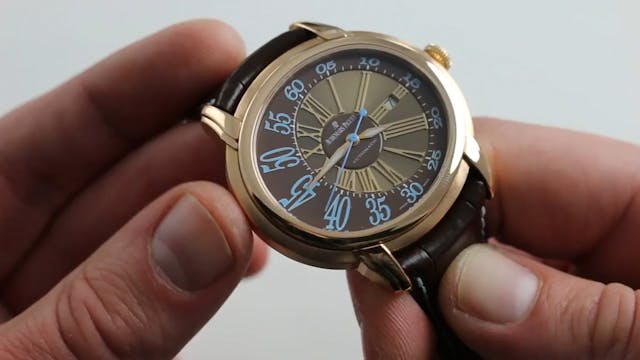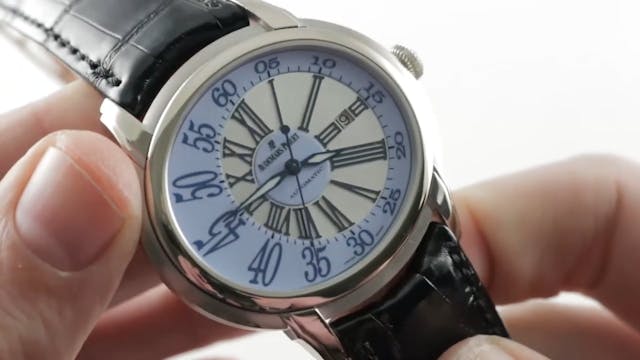Audemars Piguet Royal Oak Mid Size (15450ST.OO.1256S) Review
Audemars Piguet Reviews
•
5m 57s
The Audemars Piguet Royal Oak mid size 15450ST.OO.1256S features a 37mm stainless steel case surrounding a silver Grande Tapisserie dial on a stainless steel bracelet with folding buckle.
The Royal Oak mid size 15450 uses the same Audemars Piguet manufacture caliber 3120. This automatic movement boasts a 60-hour power reserve, a full balance bridge, and a Gyromax-style free sprung balance. The Royal Oak is water resistant to 50 meters thanks to a screw down crown. Functions include hours, minutes, seconds and date. The watch also measures 9.9mm in thickness and 46.7mm from lug-to-lug.
For complete details, watch the full review!
Shop AP: https://www.thewatchbox.com/watches/audemars-piguet/
Hi, I'm Tim. Welcome to our channel and thanks for logging on. If you enjoy these videos, do me a favor and subscribe to our YouTube channel right here at WatchBox Reviews. I would really appreciate it, and I promise to update daily. If you love this AP ref. 15450, you can see it and you can purchase it on our website, the watchbox.com.
Today, we were discussing the Audemars Piguet Royal Oak 15450, the 37mm Royal Oak Automatic that features the same degree of craft, care, finish, and manufacture movement prowess as the 15400, but, in a far more wearable 37mm case. In many ways, the successor to the beloved reference 14790. This watch is the more natural fit for my 16cm circumference wrist than the quasi-Offshore 41mm steel equivalent, the 15400. The watch is easy to wear, it's also slim. The timepiece measure only 9.9mm thick with a generously sloped case flank—you can see how a cuff will easily slide up and over this one. Every Royal Oak lug-to-lug is bigger than its round case dimensions suggest. This is a 37, but lug-to-lug, it’s 46.7. And, if you include those rigid plots, the end links that cause the bracelet to flare, you wind up with 49.7mm across the wrist, which is to say that the watch effectively wears like a 39 or 40mm round watch, and that's something you need to take into account when you buy yourself a Royal Oak or an Offshore. You have to imagine the watch being one or two sizes larger and then think about how that will fit on your wrist.
The good news here is that there's no compromise. The scale is different, but the detail is the same. Getting real close, you can see that the level of attention to detail lavished on this case, this bezel, these links, is the same as on every steel Royal Oak. It's far easier to finish gold and platinum with this kind of hairline bevel, perfectly aligned across components, than it is to do the same with steel. Remember back in 1972, the original Basel display pieces that AP showed, the prototypes of the Royal Oak, they were actually white gold because AP didn't then have the tooling to create those forms and that finish in steel. It's tough on both the finisher and the equipment.
Vertical satin finish on the flank, hairline bevel, linnear satin across the top. And, you'll even note, as I articulate the bracelet, the inner facings of these intermediate links are polished. You can only see their dazzling twinkle as you flex the bracelet. That is attention to detail. Nicely made, too—all removable links fixed by screws, and a clasp that feels substantial enough to be attached to an Offshore. Twin trigger—you can see it features a double deployant action, but everything is thick. Look at the cross section of that chassis and the swing arms. This one is built to last. No concerns when this one is buckled down on the wrist. Twin triggers also ensuring that it can't accidentally pop open. And, look at this double finish, both satin and blasted, in a component you'll scarcely ever see.
Jumping back to the case—handsomely executed. It's a Royal Oak. It's a combination of curves and sharp angles, of sheer faces and sensuous bends. You'll also appreciate the fact that the contrast between polished and satin is strong with this one and little signs that this watch is nice and crisp—factory fresh include both the sharp break between the satin finish top of the bezel and the polished edge, as well as the clear recess of the white gold hexagonal bezel bolts within the bezel. These should always be recessed on a Royal Oak. When they're flush, that's Audemar Piguet’s threshold for replacement.
So the timepiece, wonderfully crisp, is the same on its dial side. Silver, tapisserie dial—it is not the mega tapisserie that's stamped on the Offshore. It is the traditional tapestry, sometimes called petite tapisserie, cut on a pentagraph lathe, which essentially takes a giant model of this dial and then transcribes the pattern onto the dial itself. And this is a lathe made in the 19th century. AP once contracted it out to Stern Frare since 2012, and the debut of this model doing it all in-house, but still the old fashioned style of construction. White gold indices, white gold hands, white gold AP logo, tarnish-free forever, plenty of lume—there will be a lume shot. Minimalist date window—AP went without an aperture, so it's muted. You don't really see it. It's there when you want it, but it blends in otherwise and it features a quick set. The crown, echoing the hexagonal bolts on the bezel, screw down 50m water-resistant, and inside the case you can see this one is a K series. You can see Audemar Piguet manufacturer caliber 3120. Let me see if we can get a little bit closer here, a little bit closer, try to restore the focus and the definition. Now, the movement itself is a 60-hour automatic—this is also the base on the Offshore. So, it's built for sports watches and it's tank tough. For a high horology caliber, this one's a bomber.
Full balance bridge with a free-sprung index, both for precise regulation and resistance to shock-induced timing deviation. AP has a big, slow beating balance at 21,600 vibrations per hour, but this Gyromax-style balance is made huge. So it doesn't have a high rate, but it has huge inertia and that's how it resists deviation. The rotor itself—bidirectional winding 22k gold, not 21, not 18, certainly not tungsten—AP not pinching pennies here. Bidirectional rotating because it didn't want the unidirectional wobble, and it's manufacture movement that people associate with Hublot Valjoux 7750s, and also the same as often used in Panerai of the 2000s. So, this bidirectional winding—it has no rotor wobble whatsoever, and the ceramic rotor bearings un-lubricated and essentially sealed for life. They require no maintenance and they help to recover some of the efficiency lost by the smooth bidirectional system. It has both hacking seconds and a quick set date—nicely hand finished. You can see it's engraved with the coats of arms of both the Audemars and Piguet family. AP still in the hands of the founding families today. Since 1875, the largest and oldest watch brand still in the hands of the founders. Black, polished crew heads, linear, and a handsome, albeit machine applied, scampering at the edge of all the bridges. It's a hybrid of hand finish and machine finish, but impeccably executed and wonderfully visible.
Up Next in Audemars Piguet Reviews
-
Audemars Piguet Millenary Ref. 15320O...
-
Audemars Piguet Millenary Automatic (...
-
Audemars Piguet Royal Oak (Black Dial...



